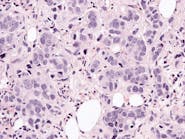Deaths from breast cancer dropped 58% between 1975 and 2019 due to a combination of screening mammography and improvements in treatment, according to a new multicenter study led by Stanford Medicine clinicians and biomedical data scientists.
Nearly one-third of the decrease (29%) is due to advances in treating metastatic breast cancer —a form that has spread to other areas of in the body and is known as stage 4 breast cancer or recurrent cancer. Although these advanced cancers are not considered curable, women with metastatic disease are living longer than ever.
Caswell-Jin and Liyang Sun are co-first authors of the study, which was published Jan. 16 in the Journal of the American Medical Association. Sylvia Plevritis, PhD, professor and chair of biomedical data science, and Allison Kurian, MD, MSc, professor of medicine and of epidemiology and population health, are co-senior authors.
The study was a collaborative effort by a national consortium of researchers called CISNET, or the Cancer Intervention and Surveillance Modeling Network. CISNET was established in 2000 by the National Cancer Institute to understand the impact of cancer surveillance, screening and treatment on incidence and mortality. Doing so requires sophisticated computer algorithms capable of modeling the natural course of the disease and the typical treatment paths of individual patients, then translating that information to population-level data collected by the national Surveillance, Epidemiology, and End Results Program, or SEER registry, from 1975 to 2019.
The study is the third in a trio of papers from CISNET published since 2005 that assess the relative contributions of regular screening and treatment advances on breast cancer deaths.
The current study is one of the first to explicitly include patients with metastatic breast cancer in its models. The finding that 29% of the decrease in mortality is due to advances in treating metastatic breast cancer both surprised and gratified the researchers.
The CISNET researchers used four computer models to assess the SEER data from 1975 to 2019 — one developed at Stanford Medicine in the Plevritis Lab, one by researchers at the Dana-Farber Cancer Institute, one at MD Anderson Cancer Center, and another jointly developed by researchers at the University of Wisconsin and Harvard Medical School. The four models came up with remarkably similar estimates for the impact of each intervention: screening mammography, treatment of early-stage (stages 1, 2 or 3) breast cancer and treatment of metastatic breast cancer.
The models reproduced the decline in mortality in breast cancer known from SEER data, from 48 per 100,000 women dying of breast cancer each year in 1975 to 27 per 100,000 in 2019 — a decrease of about 44%. The models arrived at a larger estimated reduction in mortality of about 58% because the incidence of breast cancer has risen during the same period and more women would have died had screening and treatments not improved.
The models concluded that about 47% of this reduction in mortality is the result of improved treatments for early-stage breast cancer, and about 25% is attributed to screening mammography. The remainder, or about 29%, is due to improvements in treating metastatic disease.
The impact of treating metastatic disease is exemplified by the increases in median survival time after metastasis: Patients diagnosed in 2000 with metastatic disease lived an average of 1.9 years versus an average of 3.2 years for those diagnosed in 2019. Survival time varies by subgroup status, however. Patients with what are known as estrogen receptor-positive and HER2 positive cancers saw an average increase in survival time of 2.5 years. Those with estrogen receptor-positive and HER2-negative cancers lived an average of 1.6 years longer, but those with cancers that are estrogen receptor-negative and HER2-negative lived about 0.5 years longer in 2019 than in 2000.





